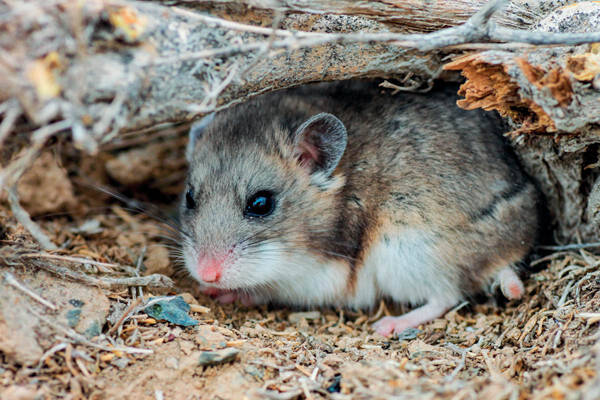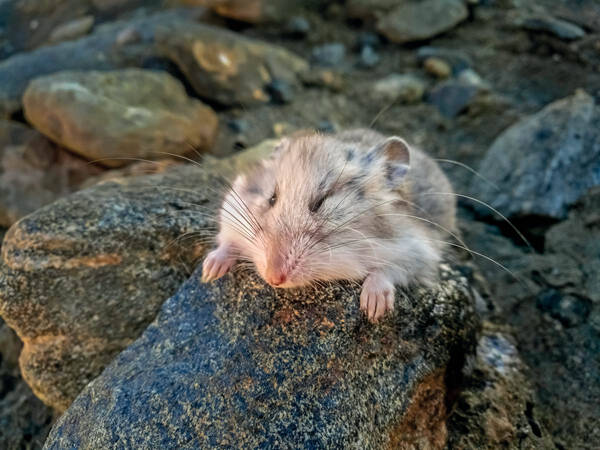Cricetulus migratorius
IUCN
LCBasic Information
Scientific classification
- name:Cricetulus migratorius
- Scientific Name:Cricetulus migratorius,Grey hamster,Hamster, moving
- Outline:Rodents
- Family:Rodentia Cricetidae
Vital signs
- length:100-120mm
- Weight:
- lifetime:
Feature
The body is relatively stout. The tail is long, which is longer than the hind legs and is about 30% of the body length. The snout is blunt and the ears are round.
Distribution and Habitat
Domestically, it is distributed in Xinjiang, Gansu, Inner Mongolia, Ningxia, Qinghai and Shaanxi. Abroad, it is distributed in Mongolia, Kazakhstan, Russia and even southeastern Europe.
The gray hamster has a wide range of habitats, from desert plains, semi-desert plains, low mountain and hilly grasslands, mountain grasslands, mountain forest grasslands, all the way up to subalpine meadows, and even alpine meadows above 3000m above sea level. In the mountains, shrub grasslands, forest edges, nurseries, river valleys and hillside gravel piles, as well as temporary civil buildings and livestock sheds or houses are mostly selected as habitats; in the plains, farmland, canal banks, forest belts, fallow land, graves, ridges and other places are selected as habitats.
Appearance
The individuals are relatively large, usually over 100mm, with tail length about 30% of the body length. The back of the body is lighter in color, mainly grayish white, and some older individuals have light brown on the back. The base of the hair on the abdomen is gray, with white tips. The ears are relatively large, different from other hamsters, usually about 18mm, without white edges. The tail is consistent from top to bottom, white. The skull and teeth are basically the same as other hamsters.
Details
The gray hamster belongs to the subfamily Cricetinae. The taxonomic status of this species is stable, and there are many subspecies, 15 of which are described, 3 of which are in China. It is a species with strong adaptability. According to records (Luo Zexun et al., 2000), this species is distributed in deserts, semi-desert grasslands, low mountains and hills, mountain forests, shrub grasslands, forest grasslands, dry grasslands, and even salt marshes, fixed and semi-fixed sand dunes. On the Pamir Plateau, Liu Shaoying et al. found that the habitat of this species is very harsh. In extremely dry and cold habitats, where there is almost no grass, and the coverage of shrubs such as ephedra is less than 1%, the gray hamster's clip rate is about 5%. This shows that the gray hamster has an extraordinary ability to resist harsh environments.

Gray hamsters live in caves, and the caves are relatively simple. They build nests under large pieces of gravel, fallen trees and other natural shelters. In agricultural areas, they like to build nests in ridges, earth mounds, grain stacks and haystacks. In urban residential areas, they can also nest in buildings and houses. The entrance to the cave is often in a dark place, usually with 2 to 3 exits, 1 or 2 nesting chambers and several warehouses. The diameter of the cave is 2 to 4 cm, and the tunnel goes vertically into the ground. After reaching a certain depth, it becomes a parallel tunnel, and the deepest is about 1 meter. The cave system covers an area of about 2m2. The rat holes are scattered, unlike the gerbils which have caves in groups.
The gray hamster has strong mobility and can be active in day and night, but mainly at night, especially at dusk and dawn. The range of activity is small, generally not exceeding its habitat. It moves alone, does not hibernate, and mostly moves under the snow in winter.

The gray hamster has a complex diet, including seeds and stems of various crops, as well as various wild plants, insects and mollusks (larvae of Lepidoptera). It likes to store food, and its nest stores hundreds of grams of food. The sac can carry seeds at a time, such as more than 40 sunflower seeds.
Gray hamsters have strong reproductive capacity and can reproduce up to 3 times a year. The breeding season is from March to September, and the peak breeding period is from June to July. Usually 5 to 8 pups are born per litter, and up to 13 pups can be born. The pups leave the cave and start to move alone at about 3 weeks old, and can join the breeding population in the autumn of the same year.
Listed in the 2008 Red List of Endangered Species of the World Conservation Union (IUCN) ver 3.1 - Least Concern (LC).








